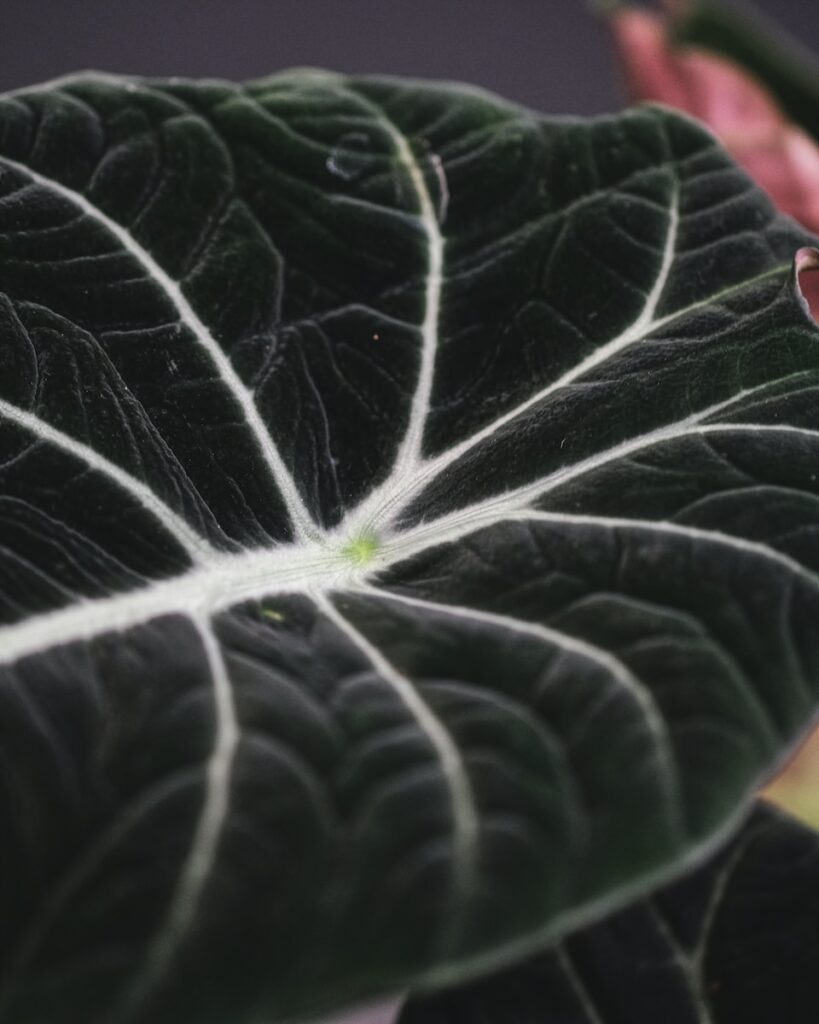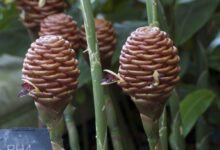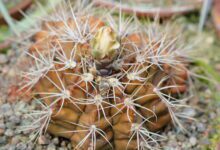Story of Day :
Are you looking for a houseplant that can add elegance to your space while also requiring minimal maintenance? Look no further than the Alocasia Black Velvet plant. This exotic plant is an intriguing beauty with its unique velvet-like appearance, deep green leaves, and contrasting white veins.
In this blog post, we will cover everything you need to know about caring for the Alocasia Black Velvet plant including light requirements, watering needs, temperature & humidity preferences, soil requirements as well as propagation techniques and common problems associated with them. So let’s dive in!
Contents
Introduction to the Alocasia Black Velvet Plant
The first thing that catches everyone’s attention when they see the gorgeous dark-colored foliage of an Alocasia Black Velvet is how striking it appears among other plants. These tropical beauties originate from Southeast Asia (the Philippines) where they thrive under high-humidity conditions around 60-80°F or even hotter weather if possible.
Their distinctive emerald-green heart-shaped leaves are adorned by small bunches called ‘inflorescences’ that look like little tails coming out between leaf sections making what may seem somewhat dull at plain sight into something stunningly beautiful after all – adding life elegantly into any garden indoors/outdoors where things might have previously looked too boring or toned down.
Alocasia black velvet care tips
Taking proper care of your beloved indoor companion requires some basic knowledge on various important factors such as light requirement levels (so never place this one directly facing open windows), watering frequency limits based upon overall exposure time outdoors compared against environmental variables within environments present inside homes-office buildings alike; different fertilizer combinations constantly adapting alongside most importantly adequate ventilation.
Light Requirements:
To ensure optimal growth in their new habitat environment make sure to always place the plant in bright indirect light rather than one exposed to direct sunlight that can lead to irreversible damage due its sensitivity. Find a spot with filtered light or place it where morning sun and afternoon shade is optimal.
Watering Needs:
The watering needs of Alocasia Black Velvet plants are crucial for their health, so make sure they’re regularly checked every other day but don’t overwater them either! Avoid allowing this beauty sit on standing water as excessive amounts could encourage rotting roots before time causing some problematic situations if left unattended.
Always remember, the top layer should dry out between your irrigation sessions which occur once every 2-3 days depending upon temperature levels indoors vs outdoors until you reach winter months; when these beauties slow down growth & require less moisture.
Temperature and Humidity Requirements:
These tropical beauties thrive under warm humid conditions ranging from around mid-sixties degrees Fahrenheit up into ranges about seventy-eighty degrees F with regular misting & possibly better yet extra humidity through use of air-conditioner/humidifier during summer season given best environment suitable present without sudden environmental changes thus avoiding stress accumulation potentially leading towards increased disease susceptibility within foliage maintaining adequate health prone against any potential diseases forming at an alarming rate!
Soil Requirements:
A well-draining soil rich in various organic matter mixes while having desirable pH range (5.5-6.5)is recommended for planting Alocasia Black Velvet plants controlling issues related impeded root development due drainage problems associated soils/substrates previously used affecting harm distribution along below ground structures..
Feeding times balanced fertilizer throughout growing cycles proactively monitoring lower leaves yellow appearance adjusting frequency accordingly fine-tuning feeding quantity performance enhancement given organically friendly fertilizers obtained easily using compost etc…
Fertilization Needs
Maintaining proper fertilizing requirements will assist the Alocasia Black Velvet plant’s growth as well.
The goal with a balanced fertilizer that has an equal mixture of nitrogen, phosphorus, and potassium should be applied throughout every two weeks during the growing season. In winter months decrease fertilization frequency.
It is crucial to avoid over-fertilizing your plants damaging leaves or even root structure! Organic fertilizers will protect both the roots & foliage while potentially providing improvements in overall visible appearance due ingredients used within.
Propagation Options
If you’re propagating these beauties for use either aesthetically inside/outside gardens future needs then respecting basic simple steps can ensure rapid development times enhancing visual appeal similarly modern-style decor arrangements versus traditional styles involved propagation methods inclusive division stem cutting tissue culture achieves same stage thriving health showcasing dark beauty genius!
A) Division:
Root ball separation into several plants replanted in different containers promotes further yields eventually reaching satisfaction enthusiasts like yourself bearing similar charm indoors-outdoors alike urging others to adopt upon realizing significant benefits ensuing proper care maintenance levels upheld constantly vs singular-related species present!
B) Stem Cutting:
Easy yet effective way most suitable involves taking portions from established stem segments along small clusters planting water-soilable concentrations allowing excess moisture drainage given optimal hygroscopic environment formation accordingly!(no need additional panes/glasses)
C) Tissue Culture:
Although not recommended unless undertaken by experienced gardeners familiar technical lab equipment necessary handling – this method greatly increases success rates when looking forward increasing blooms quicker than average returns possible under alternative options previously mentioned without extensive investment such may bring financial burden if unforeseen issues arise down the road so research adequately before deciding whether it suits skills needed/finance available at hand.

Common Problems and Diseases with Alocasia Black Velvet
Alocasia Black Velvet is a beautiful and unique plant that requires proper care to thrive. The most common problem with this plant is overwatering, which can lead to root rot and fungal diseases. To avoid these issues, it is essential to water the plant only when the top inch of soil is dry.
Spider mites and aphids can also be problematic for Alocasia Black Velvet plants. These tiny insects can be controlled with insecticidal soap or other organic pest control methods.
Yellowing leaves may indicate a nutrient deficiency or too much sunlight. It’s important to fertilize the plant regularly with a balanced fertilizer and provide it with bright, indirect light.
Proper ventilation and humidity levels are crucial for preventing bacterial leaf spot and other plant diseases. Investing in a humidifier or placing the plant on a pebble tray with water can help maintain the ideal humidity level for this stunning plant.
Pests/Disease Risk
Alocasia Black Velvet is a beautiful plant, but it is prone to certain pests and diseases. Spider mites, mealybugs, and root rot are common problems that can affect this plant. To prevent infestations, make sure there is good air circulation around the plant and avoid overwatering.
If you notice any signs of pest or disease damage, isolate the plant immediately and treat it with appropriate methods such as insecticidal soap or neem oil. Regularly inspecting your Alocasia Black Velvet for signs of problems can help catch issues early on and prevent them from spreading. While these issues can be concerning, taking proper care of your Alocasia Black Velvet can help ensure it remains healthy and vibrant for years to come.
Curling Leaves
One of the most common problems that Alocasia Black Velvet plant owners face is curling leaves, which can be a sign of several issues. Overwatering, underwatering, or pest infestations are common culprits. To remedy this, it’s important to check the soil moisture level and adjust watering accordingly. Additionally, inspect the plant for pests such as spider mites or mealybugs and treat them promptly.
It’s also important to make sure that the plant is getting adequate but not direct sunlight as direct sunlight can also lead to leaf curling. Consider adjusting the humidity levels around the plant by using a humidifier or placing a tray of water nearby to provide some extra humidity. With proper care and attention, you can keep your Alocasia Black Velvet plant healthy and beautiful.
Yellowing Leaves
One of the common problems that can affect the Alocasia Black Velvet plant is yellowing leaves. This can be caused by a variety of factors, such as overwatering or underwatering. It’s important to make sure that the plant is receiving the right amount of water and is not sitting in standing water.
In addition to watering issues, yellow leaves can also indicate a lack of nutrients. Using a balanced fertilizer can help support growth and prevent nutrient deficiencies. Pests such as spider mites or thrips can also cause yellowing leaves, so it’s important to inspect the plant regularly for any signs of infestation.
To address yellowing leaves, it may be necessary to trim off any damaged or yellowed leaves to encourage new growth. By taking these steps and properly caring for your Alocasia Black Velvet plant, you can help ensure that it remains healthy and vibrant for years to come.
Brown Tips
One common problem that can affect the Alocasia Black Velvet plant is brown tips on its leaves. There are several factors that can cause this issue, including overwatering or underwatering. To prevent this, it’s important to water your plant only when the top inch of soil feels dry to the touch.
Another possible cause of brown tips is low humidity levels. Consider using a humidifier or placing a tray of water near the plant to increase the moisture in the air. It’s also important to avoid placing the plant in direct sunlight or near cold drafts, as this can lead to brown tips as well.
If you do notice brown tips on your Alocasia Black Velvet plant, it’s best to trim them off with clean scissors to keep your plant looking healthy and vibrant. By taking these steps, you can help ensure that your plant thrives and remains a beautiful addition to your home or office.

Alocasia Black Velvet Toxicity
Although Black Velvet Alocasia plants are a beautiful addition to your home or garden, it is important to be aware of their toxicity. The plant contains calcium oxalate crystals that can cause skin irritation and gastrointestinal issues if ingested. It is essential to handle the plant with care and wear gloves to avoid contact with the sap. It is also recommended that you keep them out of the reach of children and pets.
If accidentally ingested, it’s important to seek medical attention immediately. While it may be tempting to add this dark gem to your collection, proper handling and care are crucial for the health and safety of everyone in your home.
Information from Planet Natural
When it comes to Alocasia Black Velvet, it’s important to be aware of its toxicity to humans and pets. According to information from Planet Natural, all parts of the plant contain calcium oxalate crystals, which can cause severe irritation and swelling if ingested. Symptoms of ingestion include difficulty breathing, vomiting, and throat swelling. To prevent any accidents, it’s crucial to keep the plant out of reach of children and pets and to wear gloves when handling it.
In case of ingestion, seeking medical attention immediately is advised. Despite its toxicity, Alocasia Black Velvet remains a popular choice for indoor plants due to its striking dark foliage that can bring a touch of drama and elegance to any space.
Additional Resources for Alocasia Black Velvet Care and Maintenance
Alocasia Black Velvet plants are a stunning addition to any indoor garden, but they require specific care and maintenance. To ensure your plant thrives, here are some additional resources to help with Alocasia Black Velvet care:
Firstly, the soil used for these plants should be well-draining and rich in organic matter. Overwatering can cause root rot, so it’s crucial to keep the soil consistently moist but not waterlogged. The plants prefer bright, indirect light and may suffer in direct sunlight.
These plants need high humidity levels to thrive, so consider using a humidifier or placing a pebble tray nearby. Regularly check for common pests such as spider mites and scale insects as they can damage the leaves. Yellowing or wilting leaves may also indicate a pest or disease problem.
By following these tips and caring for your Alocasia Black Velvet properly, you’ll enjoy having this dark gem that shines bright in your home.
Gardening Guru
For those looking for additional resources on Alocasia Black Velvet care and maintenance, Gardening Guru is a highly recommended website. This resource offers a wealth of tips and tricks on how to properly care for this unique plant, including watering and fertilization techniques, pest and disease management strategies, and advice on the ideal soil mix for your plant. In addition, Gardening Guru provides detailed information on when to repot your Alocasia Black Velvet and how to do so correctly. With its comprehensive guides, Gardening Guru is an invaluable source of information for any Alocasia Black Velvet enthusiast wanting to keep their plant healthy and thriving.
Pest Control
When it comes to caring for your Alocasia Black Velvet plant, pest control is an important aspect to consider. These plants are vulnerable to pests such as spider mites and mealybugs, which can quickly damage or destroy the plant if left unchecked. Regularly inspecting your plant for signs of infestation is crucial, as catching the problem early can make a big difference.
There are several natural remedies that can be effective in controlling pests, such as neem oil or insecticidal soap. If the infestation is severe, chemical pesticides may be necessary, but it’s important to follow instructions carefully and use with caution.
Preventing pest problems through proper care and maintenance is key to keeping your Alocasia Black Velvet healthy and vibrant. With proper attention, you can enjoy this dark gem of a plant for years to come.
Soil & Compost
For healthy growth and maintenance of your Alocasia Black Velvet plant, it is essential to choose the right soil and compost. It is recommended to use a well-draining soil mix that contains peat moss, perlite, and vermiculite as these ingredients provide ideal conditions for the plant’s root development. Adding organic compost to the soil can also provide essential nutrients for healthy growth. However, it is important to avoid using heavy or clay-based soils that can hold too much moisture and cause root rot.
Regularly checking the moisture level of the soil and adjusting watering frequency accordingly is also crucial for the plant’s health. By providing proper care and maintenance, you can ensure that your Alocasia Black Velvet plant flourishes beautifully in your home or garden.




